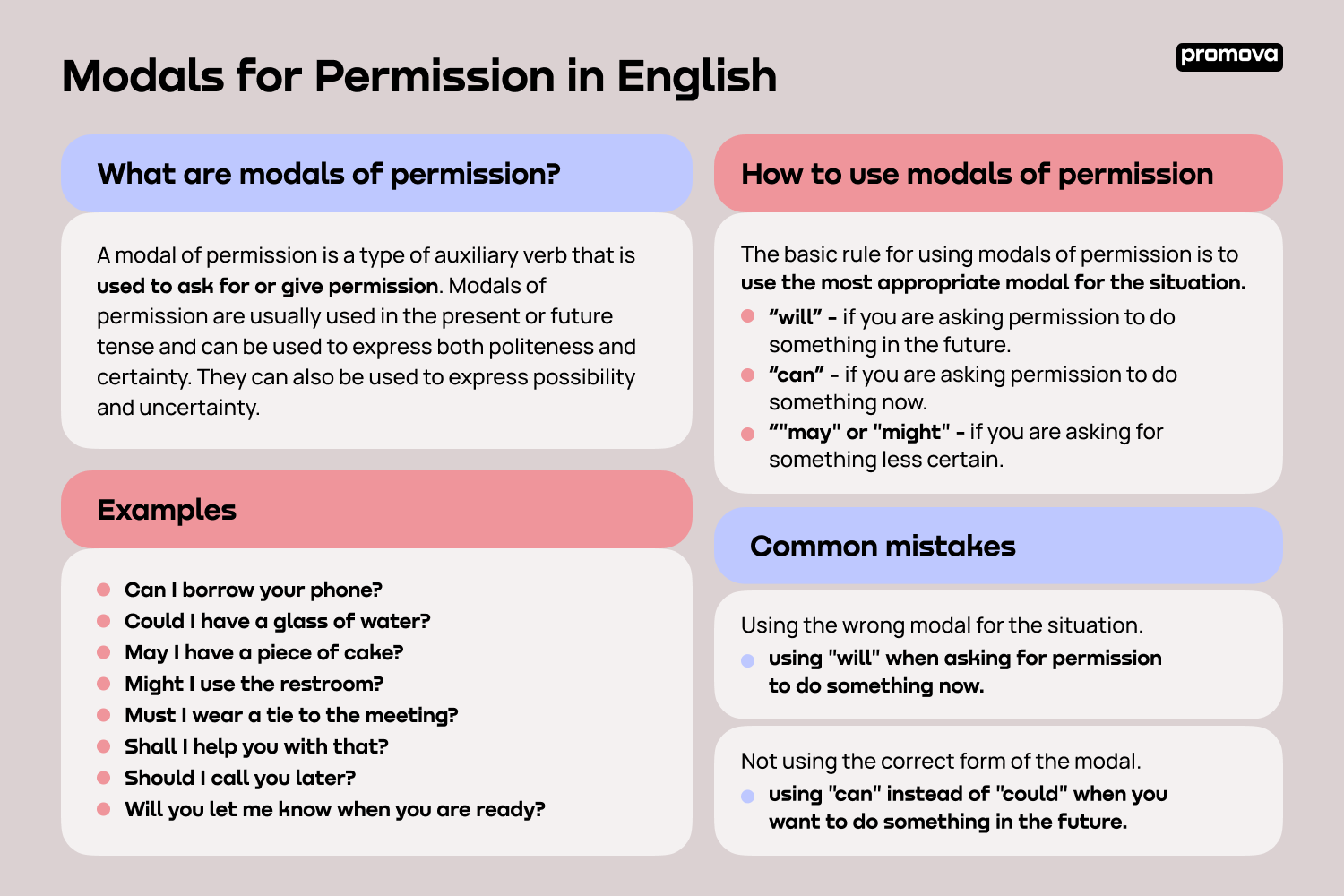Modals for Permission in English
Contents
Asking and expressing permission in English is an important part of communication, especially when interacting with people who come from different cultures.
Knowing how to use modals of permission correctly can help you to create the right impression and show respect for other cultures. In this reference, we will look at what modals of permission are, why they are important, how to use them correctly, and examples of how to express permission in different contexts.
What are modals of permission?
A modal of permission is a type of auxiliary verb that is used to ask for or give permission. Modals of permission are usually used in the present or future tense and can be used to express both politeness and certainty. They can also be used to express possibility and uncertainty.
Modals of permission are used in English to ask for permission or to express permission meaning. Examples of modals of permission include the following: can, could, may, might, must, shall, should, and will.
Examples of modals of permission
Let's look at some examples of modals of permission:
- Can I borrow your phone?
- Could I have a glass of water?
- May I have a piece of cake?
- Might I use the restroom?
- Must I wear a tie to the meeting?
- Shall I help you with that?
- Should I call you later?
- Will you let me know when you are ready?
Reasons why modals of permission are important
Modals of permission are important because they help to show politeness and help you sound more natural. They also help to make requests and offers and can be used to show deference to people in positions of authority.
Furthermore, modals of permission can be used to express uncertainty or possibility, which can be helpful when expressing doubt about something.
When used correctly, modals of permission can help to create a positive impression and show respect for other cultures. They help improve your ability to communicate in English.
4
How to use modals of permission
The basic rule for using modals of permission is to use the most appropriate modal for the situation.
If you are asking permission to do something in the future, you should use the modal "will," and if you are asking permission to do something now, you should use the modal "can."
You can also use "may" or "might" to ask for something less certain, and if you are expressing permission to do something now, you should use the modal "can."
The different types of modals of permission
There are four main types of modals of permission: can, could, may and might.
- The modal "can" is used to express the ability to do something, and can also be used to ask for permission to act in the present.
- The modal "could" is used to express the possibility of doing something, and can also be used to ask for permission to act in the future.
- The modal "may" helps express permission to do something, and is often the more polite version of "can"
- The modal "might" helps express possibility or uncertainty, and can also be used to ask for permission to do something in the future.
It is important to note that the modals "shall" and "should" are not typically used to express permission, but are used to express obligation or advice.
Expressing permission with modals – can, could, may, and might
Let's look at some examples of expressing permission with these modals:
- Can I borrow your phone?
- Could I have a glass of water?
- You may leave now.
- You might be able to go to the party this weekend.
As you can see, the modals "can," "could," "may," and "might" can all be used to ask for and express permission.
Examples of asking for permission in different contexts
Here are some examples of asking for permission in different contexts:
- In a classroom: Can I use the bathroom?
- At a restaurant: Could I have a glass of wine?
- At a store: May I try on this dress?
- At a museum: Might I take a photo?
As you can see, the modals "can," "could," "may," and "might" can all be used to ask for permission in different contexts.
Examples of expressing permission in different contexts
Here are some examples of expressing permission in different contexts:
- At a meeting: You can leave now.
- At a party: You could stay a little longer.
- At a concert: You may take photos.
- At a movie theater: You might be able to get a refund.
As you can see, the modals "can," "could," "may," and "might" can all be used to express permission in different contexts.
Common mistakes when using modals of permission
One common mistake when using modals of permission is using the wrong modal for the situation. For example, using "will" when asking for permission to do something now, or using "can" when asking for permission to do something in the future.
Another common mistake is not using the correct form of the modal. For example, using "can" instead of "could" when you want to do something in the future, or using "may" instead of "might" when expressing possibility or uncertainty.
Summary
Modals of permission are an important part of communication in English. By using them correctly, you can create the right impression and show respect for other cultures.
Improve your English with their appropriate use to sound more natural right away!
Comments